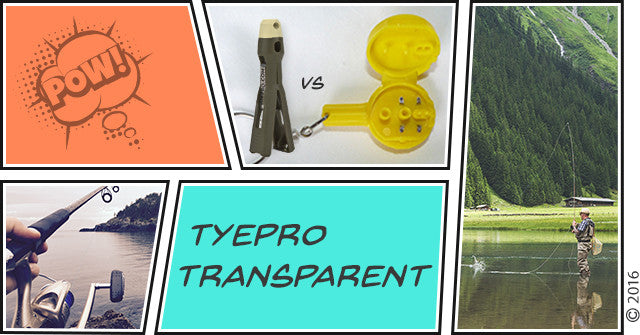Welcome to the fourth installation of TYEPRO Transparent, where we take an analytical approach in comparing our own TYEPRO tools to some of the most popular knot-tying assistants on the market. We hope you will find this thoughtful approach helpful for making a tool choice. Today we’ll be comparing our tool with the Hook Eze, a knot-tying device that puts special emphasis on keeping your hands protected while tying.
We’ll be comparing these devices along five categories: Ease of Threading, Assistance with Knot Tying, Additional Functionality, Safety and Price. You can review the basis for our comparisons here.

We’ve been wary of giving any competition an outright “zero” rating during this series, at the risk of appearing biased. I don’t think the sellers of Hook Eze would have any qualms about this rating, however: There is just no difference between threading the eyelet of a hook while it’s in a Hook Eze than there would be if you were threading it in your hand. The tool is designed for the shank and eyelet to stick out, away from the device, and that’s just the way it is. Ease of threading is TYEPRO’s bread and butter, of course. Our tool grips the eyelet, freeing up your hands to feed the line through the funnel. This funnel makes the process easy, even for those with shaky hands and weak vision.

As we mentioned above, the design of the Hook Eze results in the shank and eyelet of the hook sticking out away from the tool. That’s a weakness for helping you thread the eyelet, but it’s a benefit for tying knots. The ability to pass the lead back through the eyelet is helpful for creating palomar and similar knots. The Hook Eze also features a finger ring, which allows users to make twists as necessary, putting it at least on equal ground with TYEPRO in this regard. Although it’s strong for making Palomar knots, it actually struggles against the TYEPRO when making clinch or improved clinch knots. This is because the Hook Eze doesn’t hold the line wide enough for passing the lead between the eyelets and the twists. Which tool is a better knot-tier for you depends significantly on what knot you prefer.
One additional negative for Hook Eze is that it will not hold as wide a selection of tackle types as TYEPRO. In particular, treble hooks and many styles of jigs, especially those with plastic trailers. Flies with long feathers or significant hackle are also a problem with Hook Eze as you cannot close this tool around them without causing damage. If you can't close the tool around them, knot-tying assistance quickly drops to "zero."

The Hook Eze is the first tool we’ve looked at that shares TYEPRO’s ability to trim the tag end of the line once you’re done tying a knot. We certainly enjoy this feature when using our own tool, so we can only give our competition kudos for including it. One other “functionality” benefit comes from the Hook Eze’s headlining feature, a case that stores the hook for safety purposes. You may recall from our profile of the Lure Tamer, that hooking your tackle to the rod during transport can only result in damage to your equipment. The Hook Eze allows you to snap the tool to your rod, while shielding your rod from the damaging hook. TYEPRO’s lanyard provides a surprisingly helpful hand in keeping your tool close-at-hand, compared to the standard clip featured on most comparable tools.

Safety is the Hook Eze’s claim to fame, and it certainly dominates this category when compared to all of the knot-tying tools we’ve featured. Its key component is a plastic case that encompasses the hook while you tie your knot, which keeps your hand safe during the process. We’ve said this repeatedly throughout this series: If you’re careful with the TYEPRO or any of the other tools in this series, your hands will be fine. That said, nothing guarantees safety from nicks and cuts like the Hook Eze. Of course, the safety of the Hook Eze depends on whether you'll be able to fit your hook or jig in the case.

The Hook Eze is also the first tool that the TYEPRO can match in the price category, although we should offer a clarification: When you purchase this tool, you’re actually getting two Hook Ezes, as they come in packs of two. So, in reality, this is a great price if you need two tools. Unfortunately, if you’re only in need of one tool, there’s no way to avoid buying the second. If you want to see an explanation behind the cost of a TYEPRO, we encourage you to check out this article. Special thanks to reader Dave. R, who commented that “you have a great product at a very reasonable price.”
We’ll be rating cost as 3 for tools less than $6.00, 2 for tools between $6 and $11.99, and 1 for tools over $12.00.


